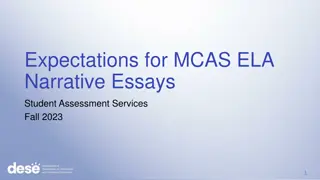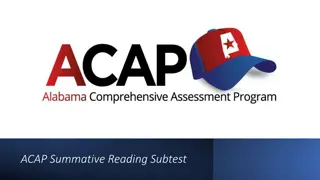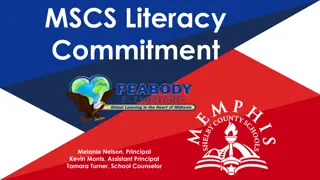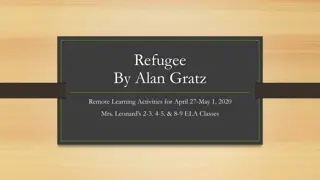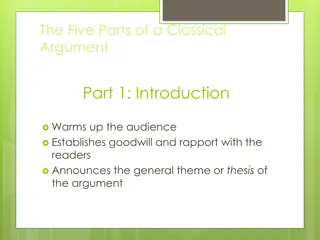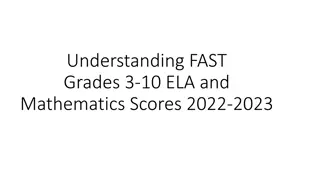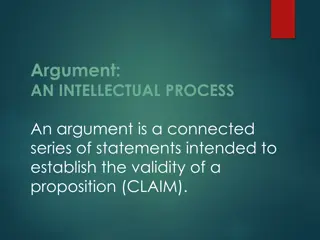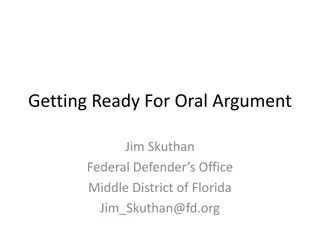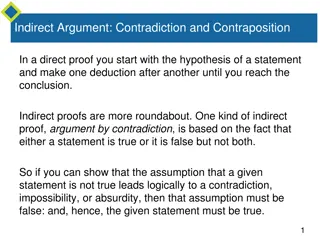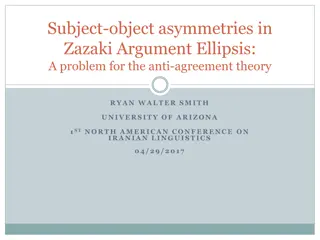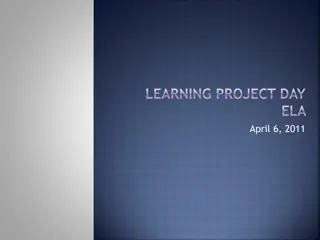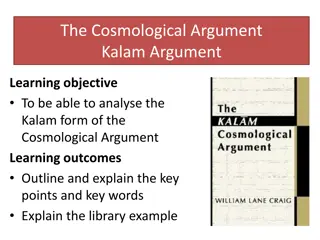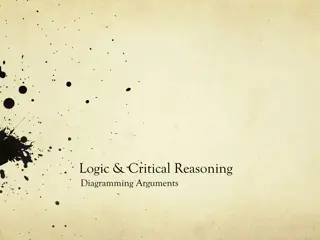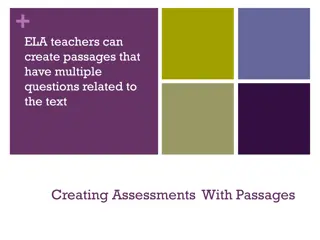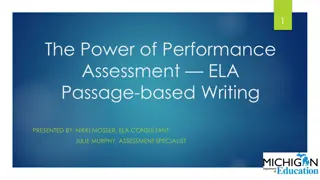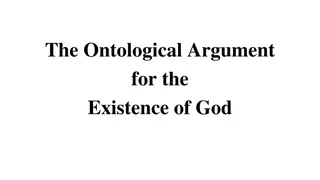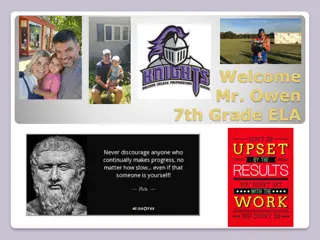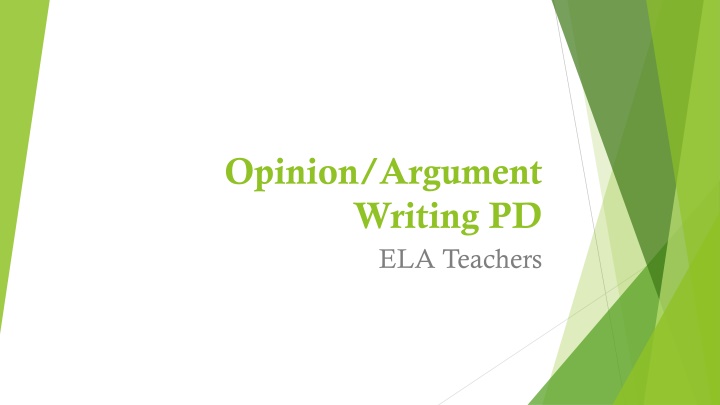
Enhancing Opinion and Argument Writing Skills in ELA Teachers
Explore the contrast between informational/explanatory and opinion/argument writing modes, focusing on why argument writing is emphasized in educational standards. Gain insight into the essential elements of opinion/argument writing not typically found in informative/explanatory writing, along with mnemonic techniques and strategies for structuring introductions effectively. Sample introductory paragraphs illustrate key components for successful opinion/argument writing.
Download Presentation

Please find below an Image/Link to download the presentation.
The content on the website is provided AS IS for your information and personal use only. It may not be sold, licensed, or shared on other websites without obtaining consent from the author. If you encounter any issues during the download, it is possible that the publisher has removed the file from their server.
You are allowed to download the files provided on this website for personal or commercial use, subject to the condition that they are used lawfully. All files are the property of their respective owners.
The content on the website is provided AS IS for your information and personal use only. It may not be sold, licensed, or shared on other websites without obtaining consent from the author.
E N D
Presentation Transcript
Opinion/Argument Writing PD ELA Teachers
Contrast of Writing Modes So far with PD this year we ve spent a considerable amount of time on informational/explanatory writing. The fall training offered by TDOE revolved around opinion/argument writing. WHY do the standards focus so heavily on argument writing? Education experts Mike Schmoker and Gerald Graff argue that argument is the primary skill essential to our success as citizens, students and workers. How do these two modes of writing differ? What things need to be included in opinion/argument writing that weren t necessarily included in information/explanatory writing?
Contrasting Mnemonics Informational/Explanatory Opinion/Argument P Pull apart prompt O Organize thoughts W Write and say more P Pull apart prompt O Organize thoughts W Write and say more T Thesis (Taking a side: What is my claim?) R 2/3 Reasons (Why do I make this claim?) E Evidence to support each reason (How can I prove each reason?) C Counterclaim (What do others think and how would I respond?) C Conclusion (Did I wrap it up right?) T Topic S Supporting Evidence E Elaboration (So what?) C - Conclusion
Starting Well A Plan for the Introduction Attention Grabber - surprising statement/statistic direct/rhetorical question relevant quote historical background anecdote Identify Problem and/or Map Background Identify the problem of the topic so the reader understands the issue and/or map out the context of the problem or provide background information needed to understand the issue. This is a good place to mention text(s) and author(s) which will be referenced. Thesis Statement - What is my claim?
Sample Introductory Paragraph In 2010,in Newburyport, Massachusetts, a disturbing incident occurred: a group of students bullied class mates by creating a false Facebook account. This anecdote and many similar ones appear in Michelle R. Davis s article Students Create Fake Online Profiles to Bully Peers. How should a school official react in such a case? According to Noor Brara in Are Facebook Likes Protected by the First Amendment? the answer is a legal dilemma. Experts disagree over whether schools have constitutional authority to punish students in these cases. Regardless of the philosophical debate, the bottom line is that school has to be a safe place for students, and safety reaches farther than the physical school building. School officials need to have jurisdiction to punish students for off- campus social media use if it becomes a safety risk and significant distraction to schools. Attention Grabber= blue Identify Problem/Map Background= green Thesis Statement= red
Another Major Difference: The Counterclaim Basically: What do others think AND how would I respond? Placement: wherever it logically fits
Counterclaim Starters Critics argue that. While it may be true that ., all in all Others may say ., but I argue that . A common argument against this position is ., but . It may be true ..;however, . It s easy to think , but when one looks at the facts While some researchers say .; nevertheless, . It is often thought (imagined, supposed, etc.) , but A more extensive list of frames/stems used in argument writing may be found on our district website: Academics->Literacy Tools->9-12 Literacy->Writing-Related Resources.
Scoring SHARE the instrument used to assess! Argument Rubric (TNCore) Argument Writing Scale - Grades 9-10 & Grades 11-12 (Pages 128-129 of Fall Participant s Pkt. Explanation on pp. 130-133)
Make It Easy on You and on Your Students! Have students highlight and/or label the required parts in different colors before they submit the essay or essay part. This serves as a checklist for the student. AND This makes grading easier and faster for you because the parts are already identified.
How can I help my students practice these skills daily? Promoting discussions where Ideas bounce back and forth like a tennis ball in a match. ***Accountable Talk*** Helping students develop and deepen arguments by sending them back to the text for more evidence, prompting them to expand on a classmate s idea or deepen the discussion. Prompt by saying, I heard ___________ say something that contradicts ... These students all said something similar ... Does anyone have a different idea?
How can I help my students practice these skills daily? Provide sentence/elaboration starters as scaffolds for students until they internalize them.
How can I help my students practice these skills daily?
How can I help my students practice these skills daily? Provide sentence/elaboration starters as scaffolds for students until they internalize them. Make it part of your practice to routinely ask questions that promote analysis, evaluation, and deep thinking. Why did you choose that evidence? How does the evidence support your position?
Not Included on Non-ELA teachers score sheets so . Links - Use words, phrases, and clauses to link the major sections of the text, create cohesion, and clarify the relationships between claim(s) and reasons, between reasons and evidence, and between claim(s) and counterclaims. Language - Consistently use formal style and objective tone. Choose precise words and phrases. Choose among simple, compound, complex, and compound-complex sentences to signal differing relationships among ideas
Literacy Resources for ELA teachers ELA Unit from Comprehensive Reading Solutions - "Knowing Your Fate Anchor Charts that Promote Use of Textual Evidence to Support Opinion/Argument 13 Strategies to Improve Student Classroom Discussions - District Website Academics->Literacy Tools->9-12 Literacy->Professional Development Argument Frames/Stems PLUS Two-page Transitional Words/Phrases Resource- District Website Academics->Literacy Tools->9-12 Literacy->Writing-Related Resources

